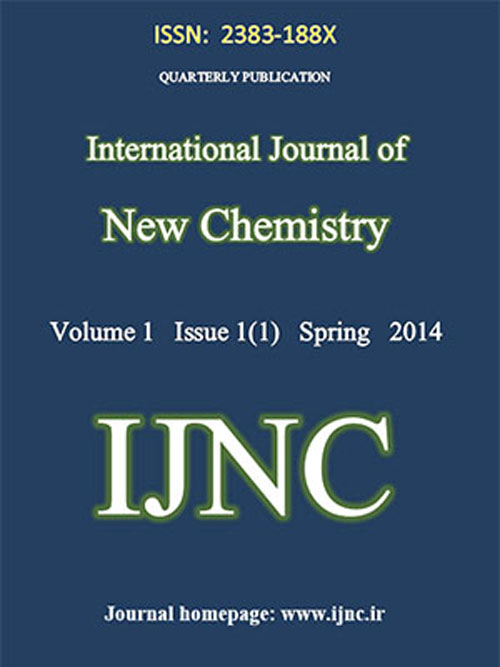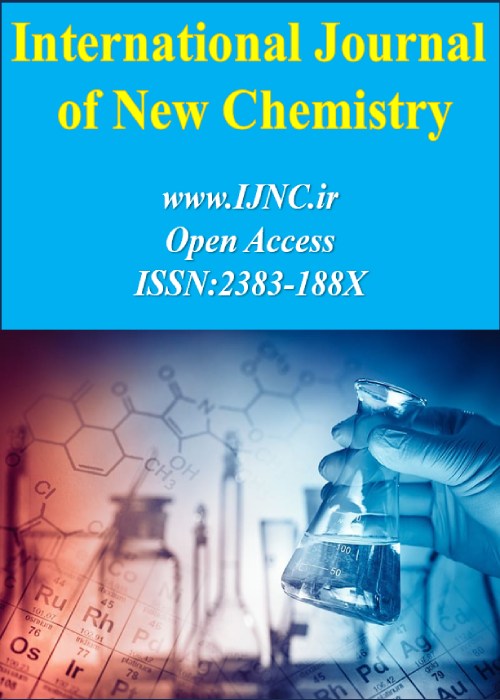فهرست مطالب

International Journal of new Chemistry
Volume:1 Issue: 1, Spring 2014
- تاریخ انتشار: 1393/03/30
- تعداد عناوین: 5
-
صفحات 30-40
-
Pages 1-9Electrical sensitivity of a boron nitride nanotube (BNNT) was examined toward aniline (C6H5NH2) molecule by using density functional theory (DFT) calculations at the B3LYP/6-31G (d) level, and it was found that the adsorption energy (Ead) of aniline on the pristine nanotubes is a bout -19.03kcal/mol. But when nanotube has been doped with Si and Al atomes, the adsorption energy of aniline molecule was increase. Calculation showed that when the nanotube is doping by Al, the adsorption energy is about -27.73kcal/mol and also the amount of HOMO/LUMO energy gap (Eg) will reduce significantly. Boron nitride nanotube is a suitable adsorbent for aniline and can be used in separation processes aniline. It is seem that nanotube (BNNT) is a suitable semiconductor after doping, and the doped BNNT in the presence of aniline an electrical signal is generating directly and therefore can potentially be used for aniline sensors.
-
Pages 10-21We report a first-principles study of electrical transport in a single molecular conductor consisting of a buthane-dithiol sandwiched between two Au (100) electrodes. We show that the current was increased by increasing of the external voltage biases. The projected density of states (PDOS) and transmission coefficients (T(E)) under various external voltage biases are analyzed, and it suggests that the variation of the coupling between the molecule and the electrodes with external bias leads to the increase of the current. Therefore, we propose that the most origin of electron transport mechanism in molecular devices is caused by the characteristics of both the molecule and the electrodes as well as their cooperation, not necessarily only by the inherent properties of certain species of molecules themselves.
-
Pages 22-29Electrical sensitivity of a boron nitride nanotube (BNNT) was examined toward C2H5OH molecules by using density functional theory (DFT) calculations . It was founding that the adsorption energy(Ead) of ethanol on the pristine nanotubes is about -51.5 kJ / mol, but when the nanotube has been doped with Si and Al atoms , the adsorption and recovery time changed and the sensitivity of nanotube toward ethanol was increased. Calculations showed that when the nanotube is doping ,the adsorption energy(Ead) is about -20.2 kJ/mol that leads to decrease the recovery time and also due to doping the nanotube with Si , the amount of HOMO/LUMO energy gap (Eg)will reduce significantly . Therefore , when C2H5OH molecule toward to BBNT, the nanotube has produced electrical signals and it seems that these nanotubes can be used as adsorbents for the sensors which are sensitive about C2H5OH molecule.
-
Pages 30-40The electronic structure and properties of the osmaabenzenes and para substituted osmabenzenes have been explored using the hybrid density functional mpw1pw91 theory. Systematic studies on the substituent effect in para substituted osmabenzenes complexes have been studied. The following substituents were taken into consideration: H, F, CH3,OH, NH2,CN, NO2, CHO, and COOH. Basic measures of aromatic character were derived from the structure and nucleus-independent chemical shift (NICS). The NICS calculations indicate a correlation between NICS(1.5) and the hardness in all species. Quantum theory of atoms in molecule analysis (QTAIM) indicates a correlation between r(Os-C) bonds and the electron density of bond critical point in all species.
-
Pages 41-50Spectrophotometric studies were successfully used in quantitative analysis of Amitriptyline Hydrochloride (ATH) Two new methods using spectrophotometry are described for the determination of (ATH) with potassium bromate as the oxidizing agent and acid dyes, Methyl orange and Indigo carmine. Both spectrophotometric methods are based on the oxidation of mentioned drugs by a known excess of bromate in acid medium and in the presence of excess of bromide followed by estimation of surplus oxidant by reacting with either Indigo carmine (method A) or Methyl orange (method B), and measuring the absorbance at 609 or 507 nm.


